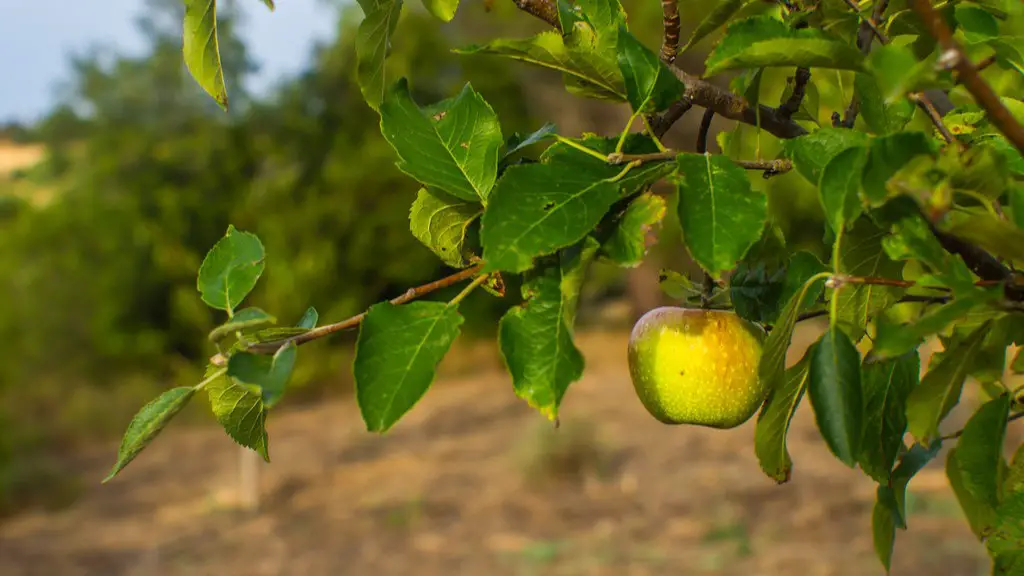When deciding on which type of apple tree to plant, several factors should be taken into consideration. It is important to acknowledge the environment, aspirations, and the expected returns of the tree before making a decision.
The first factor to consider is the climate. Apples trees require mild weather in order to grow and produce the expected yield. It is important to know the local climate and the temperature extremes as well as the normal precipitation, as they are all important growing factors. Furthermore, if the location tends to have intense wind, this should also be taken into account as heavy gales can damage the tree’s blossom and hence, the production of the crop.
The next factor to consider is the available space to plant the tree. Depending on the variety of apple trees, the space for them to grow can vary. Smaller apple trees can be planted in tighter rows and therefore can get the highest yield, while larger trees require more space around them to develop properly. Therefore, it is important to measure the available space before selecting a species.
The preferred type of apple is also an important factor. There are many different types of apples, such as Granny Smith, Golden Delicious, Honeycrisp, and Pink Lady. Each type has its own flavor and color. Some apples, such as the Granny Smith, tend to have more sour flavors, while others like the Golden Delicious are normally sweeter. Baseline knowledge of the preferred type of apple must be known before selecting the variety and should be taken into account.
The expected returns of the tree should also be taken into consideration when deciding on a variety. Some trees, such as the Northern Spy, tend to produce a heavier yield but take longer to produce it. Others, such as the Golden Delicious, are generally quicker in producing the fruits and have an average yield. Knowing the expected returns will help choose the right type of apple tree and make sure that the person planting can get the desired outcome.
The maintenance requirement is also another important factor to consider. All plants need maintenance to thrive, but some varieties require more attention than others. Some apple trees, for example the Johnathans, require more fertilization and pruning than other varieties, such as the Baldwin. Therefore, it is important to identify which type of tree requires less maintenance in order to make sure that the tree can be taken care of properly.
Finally, the disease resistance must be taken into account. Every apple tree is susceptible to certain diseases, such as scab and canker. Therefore, it is important to choose a tree that is resistant to the local pests and diseases. Research can be done on the subject in order to make sure that the tree is selected is hardy and resistant to local pests and diseases.
Factors to Consider When Planting an Apple Tree
When selecting an apple tree to plant there are several factors that should be taken into consideration. The type of apple tree chosen should suit the local environment, the size of the available space, the expected yields from the tree, the maintenance requirement and the disease resistance of the variety. It is important to research a few options before deciding on the type of apple tree to plant.
The Local Environment
The local environment should be a major factor when deciding on the type of apple tree to plant. It is important to research the local climate and temperature extremes, as well as the usual levels of precipitation and intensity of wind in the area. This will ensure the tree can survive in the conditions and produce the expected fruit yield.
The Available Space
The amount of space available to plant the tree should also be taken into consideration. Some apple trees, such as the Granny Smith and Golden Delicious, are usually smaller and can be planted in tighter rows for a higher yield. Whereas larger trees, such as the Jonathan and Braeburn, require more space around them in order to develop properly.
Preferred Type of Apple
Each type of apple tree has it specific flavor, color and texture. Some apples, such as the Granny Smith, tend to be more sour, while other types like Golden Delicious are sweeter. Knowing the desired type of apple is important, as it will determine which apple tree will produce such a fruit.
Expected Yields
It is also important to know the expected yields of the tree before making the final decision. Certain types of apples, such as the Northern Spy can produce heavier yields but take longer to produce them, while faster-growing varieties such as the Golden Delicious will have an average yield. Knowing the expected returns can help ensure the right type of tree is chosen.
Maintenance Requirement
All apple trees require maintenance in order to produce quality fruits. Some apples, such as Johnathans, might need more fertilization and pruning than other varieties, such as the Baldwin. Therefore, it is important to identify which type of tree requires less maintenance in order to make sure it can be taken care of easily.
Disease Resistance
Finally, it is important to choose a tree that is resistant to the local pests and diseases. All apple trees are susceptible to certain diseases, such as scab and canker, so researching a variety will ensure the right type of tree is selected. Knowing which type of apple tree is more resistant to the local diseases and pests will help ensure the tree can thrive in the environment.


